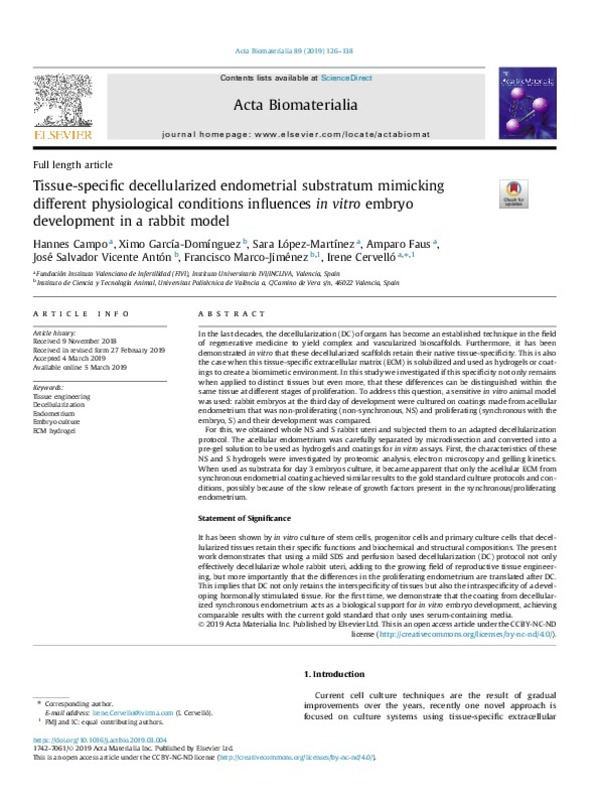|
Resumen:
|
[EN] In the last decades, the decellularization (DC) of organs has become an established technique in the field of regenerative medicine to yield complex and vascularized bioscaffolds. Furthermore, it has been demonstrated ...[+]
[EN] In the last decades, the decellularization (DC) of organs has become an established technique in the field of regenerative medicine to yield complex and vascularized bioscaffolds. Furthermore, it has been demonstrated in vitro that these decellularized scaffolds retain their native tissue-specificity. This is also the case when this tissue-specific extracellular matrix (ECM) is solubilized and used as hydrogels or coatings to create a biomimetic environment. In this study we investigated if this specificity not only remains when applied to distinct tissues but even more, that these differences can be distinguished within the same tissue at different stages of proliferation. To address this question, a sensitive in vitro animal model was used: rabbit embryos at the third day of development were cultured on coatings made from acellular endometrium that was non-proliferating (non-synchronous, NS) and proliferating (synchronous with the embryo, S) and their development was compared. For this, we obtained whole NS and S rabbit uteri and subjected them to an adapted decellularization protocol. The acellular endometrium was carefully separated by microdissection and converted into a pre-gel solution to be used as hydrogels and coatings for in vitro assays. First, the characteristics of these NS and S hydrogels were investigated by proteomic analysis, electron microscopy and gelling kinetics. When used as substrata for day 3 embryos culture, it became apparent that only the acellular ECM from synchronous endometrial coating achieved similar results to the gold standard culture protocols and conditions, possibly because of the slow release of growth factors present in the synchronous/proliferating endometrium.
Statement of Significance
It has been shown by in vitro culture of stem cells, progenitor cells and primary culture cells that decellularized tissues retain their specific functions and biochemical and structural compositions. The present work demonstrates that using a mild SDS and perfusion based decellularization (DC) protocol not only effectively decellularize whole rabbit uteri, adding to the growing field of reproductive tissue engineering, but more importantly that the differences in the proliferating endometrium are translated after DC. This implies that DC not only retains the interspecificity of tissues but also the intraspecificity of a developing hormonally stimulated tissue. For the first time, we demonstrate that the coating from decellularized synchronous endometrium acts as a biological support for in vitro embryo development, achieving comparable results with the current gold standard that only uses serum-containing media. (C) 2019 Acta Materialia Inc. Published by Elsevier Ltd. This is an open access article under the CC BY-NC-ND license (http://creativecommons.org/licenses/by-nc-nd/4.0/).
[-]
|
|
Código del Proyecto:
|
info:eu-repo/grantAgreement/GVA//GRISOLIA%2F2015%2F002/
...[+]
info:eu-repo/grantAgreement/GVA//GRISOLIA%2F2015%2F002/
info:eu-repo/grantAgreement/ISCIII//PI17%2F01039/ES/Identificación de factores regenerativos en medicina reproductiva y su aplicación como futura herramienta terapéutica para la reparación del endometrio/
info:eu-repo/grantAgreement/GVA//PROMETEO%2F2018%2F137/
info:eu-repo/grantAgreement/GVA//ACIF%2F2017%2F118/
info:eu-repo/grantAgreement/MINECO//BES-2015-072429/ES/BES-2015-072429/
info:eu-repo/grantAgreement/AEI/Plan Estatal de Investigación Científica y Técnica y de Innovación 2013-2016/AGL2017-85162-C2-1-R/ES/MEJORA GENETICA DEL CONEJO DE CARNE: ESTRATEGIAS PARA INCREMENTAR LA EFICACIA DE LA MEJORA, REPRODUCCION Y SALUD DE LINEAS PATERNALES/
[-]
|
|
Agradecimientos:
|
This study was supported by the following entities: GRISO-LIA/2015/002 (HC); PI17/01039 (IC); Prometeo/2018/137 (IC); AGL2017-85162-C2-1-R; BES-2015-072429 (XGD); ACIF/2017/118 (SLM). The proteomics laboratory is a member ...[+]
This study was supported by the following entities: GRISO-LIA/2015/002 (HC); PI17/01039 (IC); Prometeo/2018/137 (IC); AGL2017-85162-C2-1-R; BES-2015-072429 (XGD); ACIF/2017/118 (SLM). The proteomics laboratory is a member of Proteored, PRB3 and is supported by grant PT17/0019, of the PE I + D + i 2013-2016, funded by ISCIII and ERDF.
[-]
|









